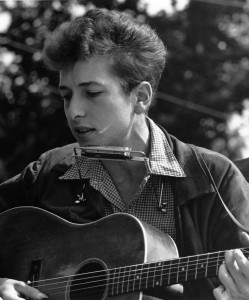Folk music has been around as long as humans have been able to speak. It’s the free-form and traditional songs of people that was passed down. The name, folk music, was coined in the 19th century when scholars and composers started collecting these folk songs and melodies from different cultures.
Modern folk music gained popularity during the early 20th century, particularly during the Great Depression. Musicians such as Woody Guthrie and Lead Belly sang about the struggles of the working class and the marginalized, and their music became a voice for social and political activism.
In the 1950s and 1960s, Greenwich Village in New York City became the center of the folk music scene. It was home to a community of musicians, poets, and artists who gathered in coffeehouses to share their work and ideas. Typically, singers weren’t paid by the coffeehouse, but a hat or basket was passed through the audience.
The coffeehouse atmosphere was intimate and relaxed. There was often a list of musicians waiting for stage time, and they, along with the audience changed often. Musicians would “make the rounds”, going from one coffeehouse to another. Music was most often performed acoustically, with singers accompanied by only a guitar or piano. It was quite different from commercially produced popular music.
Notable Singers
New York coffeehouses grew an impressive assortment of talent. Bob Dylan was perhaps the most notable. Here’s where he began his career as a singer-songwriter in the early 60s. He performed at popular coffeehouses such as Cafe Wha? and Gerde’s Folk City while he developed his unique folk and protest music style.
Joan Baez too was also a regular performer at the coffeehouses in Greenwich Village during the 1960s. She gained a reputation as a talented folk singer at The Gaslight Cafe and Cafe Wha?, The duo of Paul Simon and Art Garfunkel were also frequent players and developed their signature folk rock harmonies at The Gaslight Cafe and Cafe Wha.
Unfortunately, I was late to the scene. By time I visited Greenwich Village (as a listener, not a musician), the folk music scene had moved to California. There, it continued to evolve and gain popularity. California was home to a thriving counter-cultural movement, and musicians and artists were drawn to the state by its sunny climate, beautiful landscapes, and liberal social and political environment. Maybe the availability of drugs helped a little bit too. There, coffeehouse folk music continued to flourish, as musicians explored new sounds and their music evolved.
The growth of coffeehouse folk music in New York City was soon followed by a move to California, where the genre continued to evolve and gain popularity. California was home to a thriving counter-cultural movement, and musicians and artists were drawn to the state by its sunny climate, beautiful landscapes, and liberal social and political environment. In this new setting, coffeehouse folk music flourished, as musicians explored new sounds and styles and collaborated with one another to create something new and exciting.
Song About the Move
The Mamas & the Papas had a hit song that summed up their move to Los Angeles. The song, “California Dreamin'” , was released in 1965. The lyrics describe the feelings of homesickness and longing for warmer weather that the band members experienced after they moved to Los Angeles from the East Coast. The first verse starts with the lines, “All the leaves are brown and the sky is grey / I’ve been for a walk on a winter’s day / I’d be safe and warm if I was in L.A.”
New Sounds
The emergence of the folk rock movement, a fusion of folk and rock music, created anew sound that was epitomized by artists like The Byrds and The Mamas & The Papas, who blended the acoustic, introspective qualities of folk music with the electrifying energy of rock and roll. This new sound was a hit with audiences, and it helped to popularize folk rock and establish it as a distinct genre.
The growth of coffeehouse folk music in New York City and its later move to California played a pivotal role in the evolution of American popular music. This movement helped to establish a new standard for folk music and paved the way for the emergence of new genres like folk rock. The coffeehouses of Greenwich Village and the vibrant counter-cultural movement of California provided a platform for musicians and artists to connect with one another, share their ideas, and create something new and exciting. Today, the legacy of coffeehouse folk music continues to inspire and influence musicians and artists around the world.

